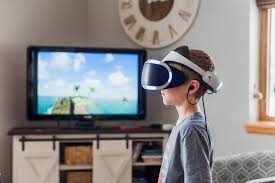What is Virtual Reality?
Virtual reality (VR for short) is emerging as the next big thing in technology. Although it has a multitude of uses, it is gaining popularity at a fast pace in the entertainment industry; and with the invention of virtual reality headsets such as the Oculus Rift and the HTC Vive, VR is becoming more and more accessible.
What exactly is virtual reality?
Virtual reality could be, essentially, any virtual form of media that mimics our reality. When most people mention VR, however, they are referring to an interactive, 3-d, computer-generated world accessed via a VR headset.
Although VR is just now making the leaps and bounds that can make it into a household name, it has been around for quite some time. In fact, the first technological advance on the road to its realization can be traced back to around 1929. Here is a timeline of how virtual reality has progressed over the years.
1838 – The Stereoscope
The very first VR-like apparatus was the stereoscope. Invented by Sir Charles Wheatstone, its use depended on viewing two side-by-side stereoscopic images through a stereoscope, affording the user a sense of depth in the scene that they were viewing.
This new fun pastime was dubbed “virtual tourism.”
The design principles of the stereoscope are still very much in use today. In fact, Google’s Cardboard VR headset borrows many design principles from the stereoscope. It is also used when examining x-rays and taking aerial photographs.
1929 – Flight Simulations
In 1929, Edwin A. Link Jr. created the very first flight simulator — The Link Trainer. The machine was essentially a grounded metal body of an airplane that had mechanisms that simulated flight. The US Army later adopted the Link Trainer as a safety feature in pilot training. It came complete with a simulated view of the battlefield, mechanisms to emulate turbulence, and a communications system. It contributed greatly to the war effort in WWII.
1950s – The Sensorama
Despite its lack of success, the Sensorama took things to the next level in the development of VR. Invented by inventor, philosopher and filmmaker Morton Heilig, it offered an immersive experience through the use of a 3D stereoscopic display, fans, speakers, a moving chair and odor dispensers. Built for use by up to four people at a time, users could watch a line-up of six short films: Motorcycle, Belly Dancer, Dune Buggy, Helicopter, A Date With Sabina and I’m a Coca Cola Bottle.
Due to the importance of his contributions to VR, Heilig is often considered to be the father of Virtual Reality.
1961 – Headsight
At this point in our timeline virtual reality begins to take on a form closely akin to current technology. The Headsight was the first ever motion-tracking head mounted display, or HMU. Hooked-up to a camera that would swivel in synch with the user’s head, it was used by the military to observe potentially dangerous regions before committing troops. Although not virtual reality in the most technical sense of the term, the head motion tracking technology used by the Headsight served nonetheless as a crucial stepping stone on the way to the creation of our modern VR headsets.
1987 – The Term “Virtual Reality” Was Coined
Amidst all these technological advancements, there had not yet been all-encompassing term to describe what this new niche was. That is, until Jaron Lanier, an employee at Sunnyvale Research Laboratory first coined the term “Virtual Reality.” From that point on, virtual reality became the widely accepted term for this type of technology.
1995 – The Nintendo Virtual Boy
At this point in time, interest in VR was steadily decreasing, and the Nintendo Virtual Boy did nothing to help that dilemma. The Virtual Boy was hyped up to be the first home console to display truly 3d graphics in a VR experience. In short, the console absolutely bombed. The graphics were horrendous and only displayed in red and black. Additionally, the headset was very cumbersome, and there were very few developers making games for the console. It was discontinued the following year. Since then, the focus of the gaming giants were scared off of these kind of gimmicks to better 3-d graphics.
Virtual Reality – 21st Century and Beyond
Today, virtual reality has made incredible leaps and bounds from where it started. The technology we have now can stimulate your senses of sight, sound, and touch with some additional accessories. Along with the standard headsets like Google Cardboard, the Oculus Rift, and the HTC Vive, there are now VR vests like the Woojer Vest that allow you to feel vibrations in accordance with what’s happening in game via subwoofers. There has even been talk of making vests and gloves that allow for you to experience temperature changes in your environment and actually touch in-game objects.
So with the technology ever-advancing, where will VR take us now? Well it turns out that the matrix wasn’t as much of a fictional movie as we though because in the future we could quite literally all have our brains hooked up to a computer living out some kind of simulation, All though the use of a computer-brain interface (CBI for short). You know how we have technology that allows amputees to control their new bionic limbs with their minds? Well, that is done via a BCI (brain-computer interface.) A brain computer interface allows the user to tell the computer what to do with their minds. Its basically telepathy but with computers.
A CBI however is the opposite. The computer downloads information directly into our brains. This means that we could possibly do things like instantly know all of Shakespeare in a matter of seconds. However, CBI’s are infinitely more complex and dangerous than BCI’s. If some thing goes wrong in a BCI, the worst that could happen is that the computer doesn’t do what you intended. With a CBI however, I could leave you permanently brain damaged or brain-dead.
For some the prospects of a future so-heavily advanced in technology is a paradise,while others envision a more dystopian conclusion. The big question is: which will it be? The answer: it depends entirely on what we decide to do with our new found superpowers and how well we handle them.
Additional Sources:
History of Virtual Reality – https://www.vrs.org.uk/virtual-reality/history.html
Virtual Reality: A Brief History – http://www.useoftechnology.com/virtual-reality-history/


Thanks, great article.